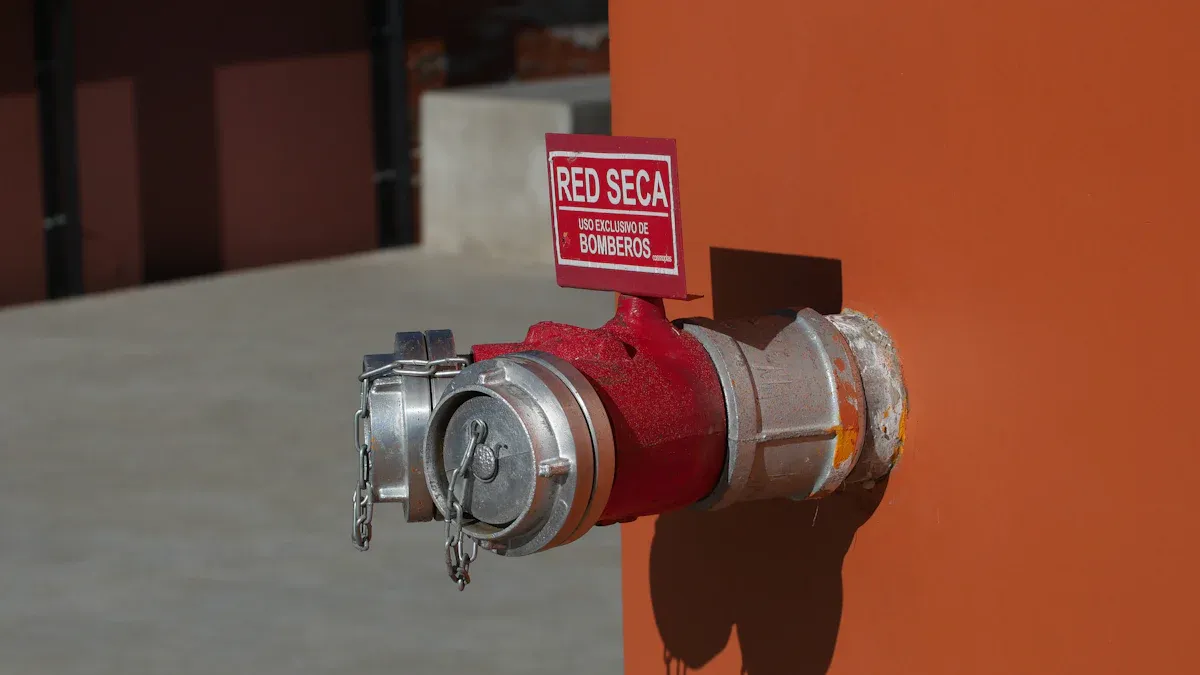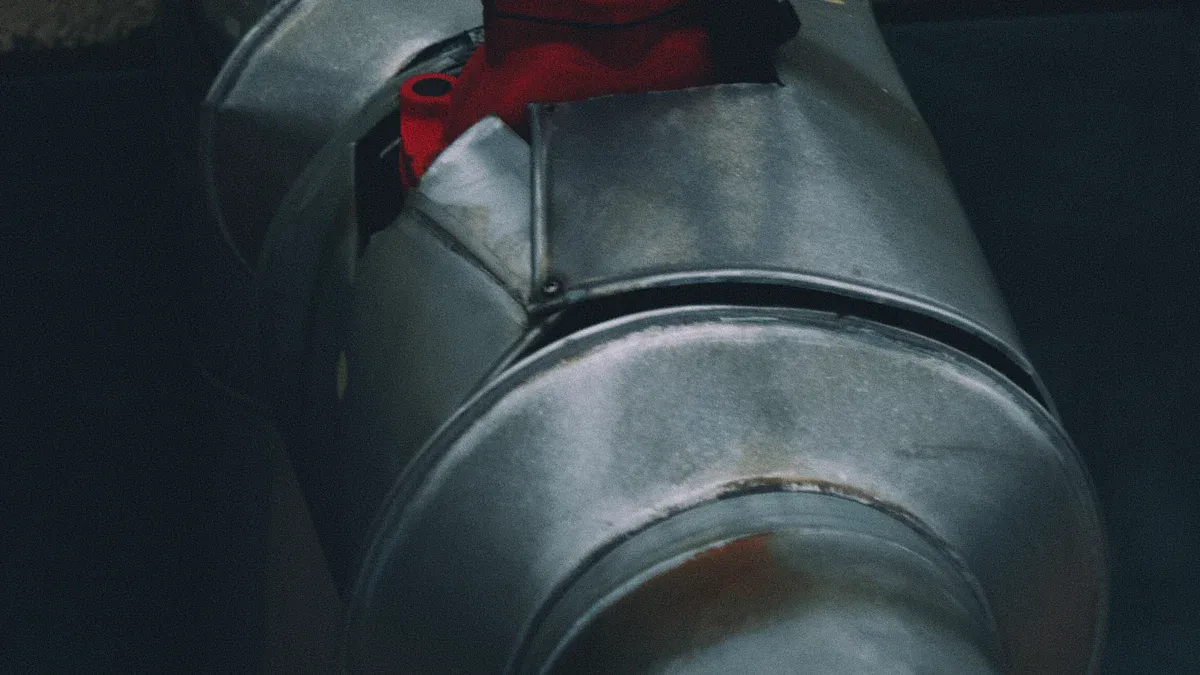
A Landing Valve With Cabinet gives you a safe and easy way to access water during a fire emergency. You will often find it on each floor of a building, protected inside a sturdy metal box. This valve lets you or firefighters connect hoses quickly and control water flow. Some cabinets include a Pressure Reducing Landing Valve, which helps manage water pressure and keeps the system safe for use.
Key Takeaways
- A Landing Valve With Cabinet provides quick and safe access to water during a fire emergency, helping control water flow easily.
- The sturdy metal cabinet protects the valve from damage and keeps it visible and easy to reach when needed.
- These valves are installed on each floor in places like hallways and near exits to ensure fast use during fires.
- Landing valves differ from hydrant valves and fire hose reels by offering indoor water control with pressure management.
- Regular inspections and following safety codes keep the landing valve system ready and reliable for emergencies.
Landing Valve With Cabinet: Components and Operation

Landing Valve Function
You use the landing valve to control water during a fire emergency. This valve connects to the building’s water supply. When you open the valve, water flows out so you can attach a fire hose. Firefighters rely on this valve to get water quickly. You can turn the handle to start or stop the water. Some landing valves also help reduce water pressure, making it safer for you to use the hose.
Tip: Always check that the landing valve is easy to reach and not blocked by objects.
Cabinet Protection and Design
The cabinet keeps the landing valve safe from damage and dust. You find the cabinet made from strong metal, like steel. This design protects the valve from weather, tampering, and accidental bumps. The cabinet usually has a glass or metal door. You can open the door fast in an emergency. Some cabinets have clear labels or instructions to help you use the valve. The bright color of the cabinet, often red, helps you spot it quickly.
Here are some common features you might see in a cabinet:
- Lockable doors for security
- Clear viewing panels
- Easy-to-read instructions
- Space for a fire hose or nozzle
How the System Works
You use the Landing Valve With Cabinet as part of a larger fire protection system. When a fire starts, you open the cabinet and turn the valve. Water flows from the building’s pipes into your hose. You or firefighters can then spray water on the fire. The cabinet keeps the valve ready for use at all times. Regular checks make sure the system works when you need it most.
| Step | What You Do | What Happens |
|---|---|---|
| 1 | Open the cabinet door | You see the landing valve |
| 2 | Attach the fire hose | Hose connects to the valve |
| 3 | Turn the valve handle | Water flows into the hose |
| 4 | Aim and spray water | Fire gets controlled |
You can trust the Landing Valve With Cabinet to give you fast access to water. This system helps keep people and property safe during a fire.
Landing Valve With Cabinet in Fire Protection Systems
Water Supply Control and Accessibility
You need fast and easy access to water during a fire emergency. The Landing Valve With Cabinet helps you control the water supply on each floor. You can open the cabinet, attach a hose, and turn the valve to start the water flow. This setup gives you control over how much water comes out. Firefighters also use these valves to get water quickly. The cabinet keeps the valve in a spot where you can find it easily. You do not have to search for tools or special equipment.
Note: Always make sure nothing blocks the cabinet. Clear access saves time during an emergency.
Common Installation Locations
You will often see these cabinets in hallways, stairwells, or near exits. Builders place them where you can reach them fast. Some buildings have a Landing Valve With Cabinet on every floor. Hospitals, schools, offices, and shopping malls use these systems. You may also find them in parking garages or warehouses. The goal is to put the cabinet where you can use it right away if a fire starts.
Here are some typical places for installation:
- Near staircases
- Along main corridors
- Close to fire exits
- In large open areas
Importance for Fire Safety
You depend on the Landing Valve With Cabinet to help stop fires from spreading. This system gives you and firefighters a steady water supply. Quick access to water can save lives and protect property. The cabinet keeps the valve safe and ready for use. Regular checks and clear labels help you use the system without confusion. When you know where to find the cabinet, you can act fast in an emergency.
Tip: Learn the locations of these cabinets in your building. Practice using them during fire drills.
Landing Valve With Cabinet vs. Other Fire Hydrant Components
Landing Valve vs. Hydrant Valve
You might wonder how a landing valve differs from a hydrant valve. Both help you control water during a fire, but they serve different roles in your building’s fire safety system.
A landing valve sits inside your building, often on each floor, and connects to the internal fire water supply. You use it to attach a hose and control water flow right where you need it. The cabinet keeps it safe and easy to find.
A hydrant valve usually sits outside your building or near the main water supply. Firefighters connect their hoses to hydrant valves to get water from the city’s main line or an external tank. Hydrant valves often handle higher water pressure and larger hose sizes.
| Feature | Landing Valve | Hydrant Valve |
|---|---|---|
| Location | Inside building (cabinet) | Outside building |
| Use | For indoor fire fighting | For outdoor fire fighting |
| Water Source | Building’s internal supply | City main or external tank |
| Hose Connection | Smaller, indoor hoses | Larger, outdoor hoses |
Tip: You should know the difference so you can use the right valve in an emergency.
Differences from Fire Hose Reels and Outlets
You may also see fire hose reels and fire hose outlets near landing valves. These tools look similar, but they work in different ways.
- Fire Hose Reel: You pull out a long, flexible hose from a reel. The hose is always ready to use and connects to a water supply. You use it for small fires or when you need to act fast.
- Fire Hose Outlet: This is a connection point for a fire hose, like a landing valve, but it may not have its own cabinet or pressure control.
A landing valve gives you more control over water flow and pressure. You can turn the valve to adjust how much water comes out. Fire hose reels give you speed, but not as much control. Fire hose outlets offer a place to connect, but may not protect the valve or control pressure.
Note: You should check which equipment your building has and learn how to use each one. This knowledge helps you act quickly and safely during a fire.
Safety Standards for Landing Valve With Cabinet
Relevant Codes and Certifications
You must follow strict safety standards when you install or maintain a Landing Valve With Cabinet. These standards help you make sure the equipment works during a fire. In the United States, you often see codes from the National Fire Protection Association (NFPA). NFPA 13 and NFPA 14 set the rules for fire sprinkler and standpipe systems. These codes tell you where to place landing valves, how to size the pipes, and what pressure levels to use.
You may also need to check for certifications. Many landing valves and cabinets carry marks from organizations like UL (Underwriters Laboratories) or FM Global. These marks show that the product passed safety tests. You can look for these labels on the cabinet or valve.
Here is a quick table to help you remember the main codes and certifications:
| Standard/Certification | What It Covers | Why It Matters |
|---|---|---|
| NFPA 13 | Sprinkler system design | Ensures safe water flow |
| NFPA 14 | Standpipe and hose systems | Sets valve placement |
| UL/FM Approval | Product safety and reliability | Confirms quality |
Tip: Always check your local fire codes. Some cities or states may have extra rules.
Compliance and Inspection Requirements
You need to keep your Landing Valve With Cabinet in top shape. Regular inspections help you spot problems before an emergency. Most fire codes require you to check these systems at least once a year. You should look for leaks, rust, or broken parts. You also need to make sure the cabinet stays unlocked and easy to open.
Here is a simple checklist for your inspections:
- Make sure the cabinet is visible and not blocked
- Check the valve for leaks or damage
- Test the valve to see if it opens and closes smoothly
- Confirm that labels and instructions are clear
- Look for certification marks
Note: If you find any problems, fix them right away. Quick repairs keep your fire safety system ready to use.
You play a key role in fire safety by following these standards. When you keep your Landing Valve With Cabinet up to code, you help protect everyone in the building.
You now know that a Landing Valve With Cabinet gives you fast access to water during a fire. This equipment helps you and firefighters control fires and protect people. You should always check that each cabinet stays clear and easy to open. Regular inspections keep the system ready for emergencies. Follow safety codes and choose certified products for the best protection.
FAQ
What should you do if you find a damaged landing valve cabinet?
You should report the damage to your building manager or maintenance team right away. Do not try to fix it yourself. Quick repairs keep the fire safety system ready for emergencies.
Can you use the landing valve if you are not a firefighter?
Yes, you can use the landing valve in an emergency. You should know how to open the cabinet and attach a hose. Fire drills help you practice using this equipment safely.
How often should you inspect a landing valve with cabinet?
You should inspect the landing valve and cabinet at least once a year. Some buildings check them more often. Regular inspections help you find leaks, rust, or other problems before an emergency happens.
What is the difference between a landing valve and a fire hose reel?
A landing valve lets you control water flow and pressure. You attach a hose to it. A fire hose reel gives you a hose that is always ready to use. You pull out the hose and spray water quickly.
Why do cabinets for landing valves have bright colors?
Bright colors, like red, help you find the cabinet fast during a fire. You do not waste time searching. Quick access can save lives and protect property.
Post time: Jun-18-2025

